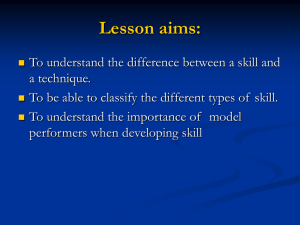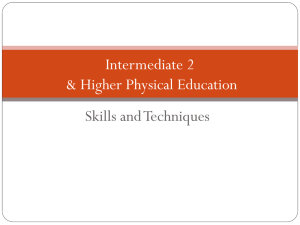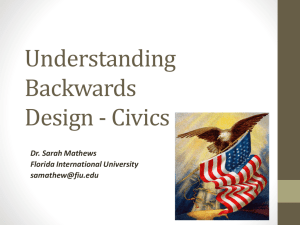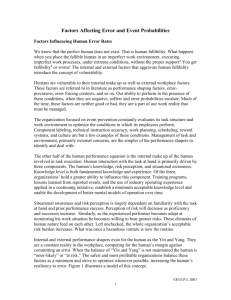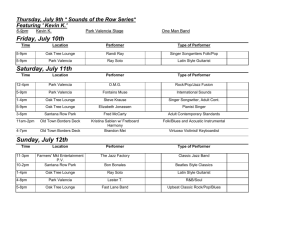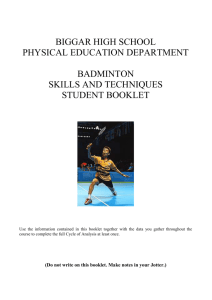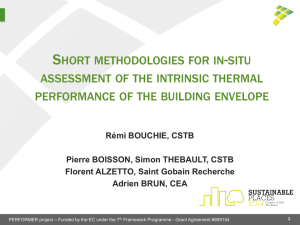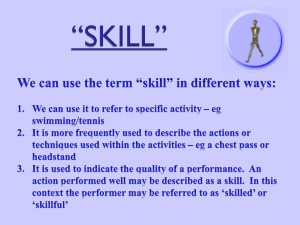Skills Techniques PPoint Ace
advertisement
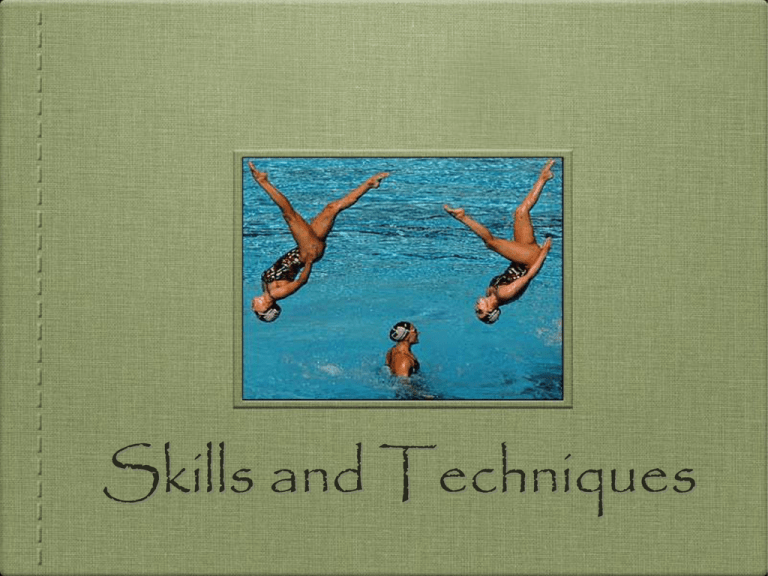
Skills and Techniques Key Concepts The development of refined technique in pursuit of performance improvement. 1. The concept of skill and skilled performance. 2. Skill/technique improvement through mechanical analysis or movement analysis or consideration of quality. 3. The development of skill and the refinement of technique, in terms of: Stages of learning Methods of practice Principles of effective practice Motivation, concentration and feedback Key Concept 1 Concept of skill and skilled performance.. Key Feature 1 How skills are performed through an information processing model Key Feature 2 How skills are performed for effective, consistent performance. Understanding of classification of skills Key Feature 3 Use of model performance. Key Concept 2 Skill / Technique through mechanical analysis or movement analysis or consideration of quality. Key Feature 1 The purposes of collecting relevant and detailed information about performance. Key Feature 2 Creation of plan using information collected about performance. Key Feature 3 Reviewing and monitoring improvements made through relevant training programmes. Key Concept 3 The development of skill and the refinement of technique. Key Feature 1 The Stages of Learning Key Feature 2 The influential factors in the development of performance Motivation, concentration and feedback Key Feature 3 How skills are learned and require refinement of technique through practice. Key Concept 1 Concept of skill and skilled performance. • To help you understand the terms of skill and technique, it will be useful to refer to the term 'technique' as how you do things and refer to 'skill' as how effectively you use techniques. Each attempt you make at combining a series of movements is called a performance. • The more skillful you are, the better your performance is likely to be. Being aware of the type of skill you are working on, will determine the way you practice and develop the skill. • A skilled performance is about your ability to be in the correct place at the correct time and be able to select the correct technique, making it look as effortless as possible to meet the performance demands Fundamental Movements • Fundamental Movements: Jumping, Catching, Throwing, Running, Walking • Basis For Development of Other Skills • Learned through other experiences, play in childhood Ability • Ability is a trait you are born with • Two Types • • Perceptual: Related to processing spatial awareness • Motor: Proficiency of movement patterns Examples; reaction time, speed of movement, balance, timing Choose one activity. Describe some of the fundamental skills you need to perform well in this activity. (4) Example: In netball, a fundamental skill I required was catching. I play GS, and I need to be good at catching fast passes from my WA and GA so that I have a chance to shoot before the other teams defence is organised. Name and explain why you use 3 fundamental skills. Key Feature 1 How skills are performed through an information processing model. Information Processing As your performance develops you are learning how to process relevant information effectively. The information processing model is one method you can use to consider how learning takes place. The model contains four parts that are linked together in a ‘learning loop’. The following diagram is an example of how the learning loop could be applied to a service reception in volleyball. Decision Making Make decisions based on the input information you have received. Sifting more important information from less important information is the second part of the loop. Input Output This is the information you receive from your senses, e.g. sight and sound. This is the way in which you decide to move and respond to the decisions you have made. Feedback During and after your chosen response you will receive information about your performance Decision Making Separate essential information from nonessential information. Make a decision. Are you closest? If so, call and move towards the ball. Input Output Position yourself correctly on court. Watch server closely. Note type of serve (e.g. underarm/overarm) Play a dig shot from your court position to a setter close to the net. Feedback Use information you receive about your performance to help you in the future. (E.g. how effective was your dig in terms of speed, flight and direction.) Choose a skill and discuss the range of information you need to consider to allow you to make effective decisions in carrying out that skill effectively. (6) Activity: Badminton Information to be considered before playing an overhead clear. The flight of the shuttle coming towards me My own positioning in relation to the shuttle My own positioning on the court My opponents position on the court My skill/ability level Key Feature 2 How skills are performed for effective, consistent performance. Understanding of classification of skills Classification of skills Simple Complex Closed Open Self Paced Externally Paced Gross Fine Discrete Continuous Serial Simple and Complex Skills Simple Skills Complex Skills Limited information to be processed A lot of information to be processed Fewer decisions to be made Many decisions to be made Processing speed slower Speed of thought crucial Accuracy not important Accuracy of skill vital to performance Fewer sub routines Many different sub routines E.g. Sprinting, swimming, cycling E.g. Vaulting, overhead clear, spike The`Open’ - `Closed’ Continuum This classification system is based on the nature of the environment in which the skill is performed. Sports such as soccer, hockey, rugby, netball and other fast ball sports usually involve open skills. • Open Skills performed in an environment which is constantly changing making decisions about an action is often difficult due to the unpredictable nature of events • Closed Skills take place in stable, predictable environments performer knows in advance exactly what to do and when to do it. Closed Skill Open Skill The Pacing Continuum This is often used in conjunction with the open - closed continuum and refers to the timing / pacing of movements. • Self-Paced Skills performer has the rate in which the skill is carried out under control • Externally-Paced Skills require the performer to pay greater attention to external events in order to control his rate of movement performer must time his movements depending on the speed of an object, or in accordance with the actions of other players Self-paced Skills Externally-paced Skills The Gross - Fine Continuum This is concerned with the precision of movement. The two extremes of the system are gross and fine motor skills. • Gross Skills involve major muscle movements not very precise and include many of the fundamental movement patterns such as walking, swimming and jumping. • Fine Skills involve more intricate movements using small muscle groups tend to be more precise in nature and generally involve a degree of hand-eye coordination. A lot of sports include skills which fall somewhere between these two extremes. Gross Skills Fine Skills The Discrete - Serial - Continuous Continuum This is concerned with how well defined the beginning and end of the skill are. • Discrete Skills identified as very brief, well defined actions have a definite beginning and end point • Continuous Skills do not have distinct beginning or end points could be stopped at any point during the performance of the skill • Serial Skills activities which fall between these two have been categorised as serial tasks serial skills are usually thought of as a group of discrete skills strung together to make a new and more complex movement Discrete skills Continuous Skills Serial Skills Choose an activity. Give a detailed description of a complex skill or technique, identifying the features which make it difficult to perform. (4) Key Feature 3 Use of model performance. • Looking at a model performer allows you to see how an action or technique should be performed. • Comparing your own performance to a model performer allows you to pinpoint weaknesses and the possible causes of poor technique. Select one skill from an activity and give a detailed analysis of the features you would expect to see in a model performance of this skill. (6) Key Concept 2 Skill / Technique through mechanical analysis or movement analysis or consideration of quality. Key Feature 1 The purposes of collecting relevant and detailed information about performance. • Here are two stages when analysing performance. i. Collect general data from a ‘match’ (full performance) situation, to highlight where in your performance the problem(s) lie. (WHAT?) ii. Adopt one of the following methods of analysis to collect specific data, which can be used to establish the cause of the problem(s). (WHY?) Analysing Movement There are three different ways of analysing movement. The type of activity you are involved in will determine which one is most suitable. Mechanical Analysis: This analysis focuses mechanical principles of movement i.e. force, levers, balance, resistance, c of g, action/reaction and planes of movement. Movement Analysis: This analysis focuses on preparation, action recovery phases of techniques and effort factors such as weight, time, space and flow. Consideration of Quality: This analysis focuses on quality within technical, physical, personal and special aspects of a performance. Mechanical Analysis In throwing events in athletics, e.g. discus, where the effectiveness of a technique can be affected by small details, a mechanical analysis may be most useful. The analysis in this example would focus on force, use of body levers and planes of movement. Force: The greater the force generated by turning, the greater the possibility of a long throw. Use of body levers: The throwing arm uses a long lever. The turning force generated needs to be transferred to the throwing arm. Planes of movement: The body can be divided into three different planes: sagittal, frontal and transverse. In the discus throw above, the athlete turns around her transverse plane to generate force. Planes of Movement Sagittal Plane Divides body into left and right Frontal Plane Divides body into back and front Horizontal Plane Divides body into top and bottom Movement Analysis • In other activities a movement analysis may provide the specific technique information you require. • An Observation Schedule covering the overhead clear is an example of movement analysis. It measures the effectiveness of a performer's preparation, action and recovery in playing a specific technique. • The criteria should cover movement to play the shot, movement during the shot and movement after hitting the shuttle. Specific Observation Schedule High Serve • This would be completed by a partner watching you repeating as many high serves as required to allow comparison of your performance with the model performer. • Alternatively you could video tape your performance and complete the schedule while watching the video. Phase of action Features of Model Performance • Stands side on to net • Feet shoulder width apart • Non racquet foot close to line Preparation • Weight on back foot • Racquet is up and back • Shuttle held out in front • Shuttle is dropped, racquet swings forward fast • Shuttle hit below waist • Whole racquet head below hand Action • Shuttle hit with whip like action • Weight transferred back to front • Feet remain in contact with floor • Racquet swing finishes across in front of body. • Returns to base Recovery • Takes up ready position Done Well Needs Improvement Consideration of Quality • This area is broken down into physical, technical, personal and special qualities. • Physical qualities include lightness of touch on a shuttle, speed around the court. • Technical qualities include the control over the racquet head, control of P.A.R. • Personal qualities include determination, perseverance. • Special qualities include deception or disguise and ability to adapt. Choose a skill and describe the method of analysis you used to identify this skill or technique as a strength in your performance. (4) Explain why you consider this method to be appropriate. (2) Key Feature 2 Creation of plan using information collected about performance. • Having collected information about your performance you are now in a position to create a plan to improve your skill / technique. • It needs to be sufficiently detailed to reflect the information you have gathered if the perceived problems are to be overcome. Key Feature 3 Reviewing and monitoring improvements made through relevant training programmes. • It is important to monitor the progress of the programme so that you can reorganize it to enable further improvement to take place. • To do this you would repeat the previous methods of analysis to identify the original weakness. You would then compare your findings with the original results to see what improvements had been made. Key Concept 3 The development of skill and the refinement of technique. Key Feature 1 The Stages of Learning Learning a skill involves three stages Cognitive Associative Autonomous Stages of Learning Important to your performance development is your understanding of the stages of learning. When planning practice sessions it is important to identify the significance of the three different stages of learning. • the Cognitive (or preparation) Stage allows you to learn or practice skills without pressure. This stage is often used with beginners or when introducing a new skill. This allows you to concentrate on basic key elements of the skill or movement. • the Associative (or practice) Stage allows you to focus on practice. At this stage the emphasis is on the correct sequence of movement patterns to produce the desired result. The repetition of the skill will become more more accurate and also more consistent. The amount of practice time needed varies with the complexity of the skill. • the Autonomous (or automatic) Stage when a performance reaches this level, movements are almost automatic with actions being carried out with very little conscious thought. Fewer mistakes are made and you are more consistent, reliable and accurate during your performance. Look at video action, in this example the performer is clearly performing at the Autonomous or Automatic stage of learning. As you can see from the practice session her movement, timing and execution of the skill is very accurate. During the game sequence she demonstrates skills effectively with control, accuracy and precision. She is totally focussed on the task and looks confident throughout her performance. Think of an activity that you have most experience in. What stage of learning do you think you are at ? Cognitive Stage first concern is to understand the task at hand learner also has to pay attention to the details of the action, rather than freeing their attention to watch what is happening around them large number of errors which leads to very variable performance errors made are usually quite gross teachers need to supply plenty of feedback which could be visual (demonstrations), verbal (instructions), or manual (physical guidance) Associative Phase concerned with practising the newly acquired skill. learner makes associations with previously learned skills fewer errors are experienced, usually caused by difficulties in controlling speed, force or timing of movements change in type of feedback, move from visual/verbal to more reliance on internal/kinesthetic Autonomous Phase • performers can produce skilled actions automatically with little or no conscious control to movement production • physical performance is highly consistent, efficient and having few errors • performers are now capable of identifying own errors and correcting themselves • performer frees his/her mind to deal more effectively with environmental information, such as player and object positions, or how a particular strategy is developing • role for the teacher is in assisting with the finer details of technique or focusing on strategy and mental preparation. Choose an activity and discuss what stage of learning you are at. Give examples of why you feel you are at this stage. (4) Methods of Practice The type of practice you select will depend on the type of skill you are learning and the stage of learning you are at. There are five main practice methods. These include gradual build up, whole part whole, repetition, pressure training and problem solving. Regardless of the method you select, your practices must be challenging, realistic and varied. Gradual build up can be used when you are learning complex skills, such as, an overhead clear in badminton. Similarly, gradual build up can be used to practice game skills. For example, you could practice and refine your passing skills before adding the pressures of coping with defending players. 'Whole part whole' can be used when there is a problem with part of the whole performance, for example, in volleyball your attack play is poor, in particular the team's setting. In your practice sessions, specific drills should be used to address this weakness before putting the skill back into the game. Repetition practice can be used when you want to establish familiarity and consistency of the skill or technique. Mainly used for closed, self-paced skills, such as, the serve in volleyball. Pressure training can be used when you want to ensure that the skill is consistently performed when under pressure. Problem Solving can be used when you want to develop decision-making skills. Gradual Build-Up i. Shadowing ii. Feeder no pressure iii. Feeder pressure iv. Combination Drills v. Conditioned Games Shadowing Allows the performer to groove the technique without any external pressure, so that it becomes automatic and the sub routines are coordinated in the correct order Feeder No Pressure The performer carries out the skill without pressure from opposition or time. The feeder plays a crucial role in supplying the performer with accurate feeds so that the skill is carried correctly. This type of practice is ideal for recognising weaknesses in the skill. Feeder Pressure Pressure can be applied in different ways. The addition of an opponent, a time constraint, accuracy tests etc., will increase the external pressure and highlight any obvious mistakes/weaknesses. Combination Drills Drills can work well when both repetition and different degrees of pressure are involved. Badminton players often practise simple repetitive drills. In such practices the aim is to keep the cycle of shots played continuously for as long as possible. If any errors occur, you would stop and restart. This is preferable to carrying on with broken, uncertain and unstructured practice. Conditioned Games The game itself is altered so that the performer is forced to carry out and practise a specific skill. For example in a game of badminton smashes can be banned and as result more overhead clears and dropshots will have to be played. Again this allows the performer to practise the skill in a game like situation. Describe in detail two different methods of practice you used to develop a complex skill. Explain why each method of practice was appropriate. (6) Principles of Effective Practice To make your practice effective, you must set realistic targets and try to apply the following key points: setting clear objectives for practice: base your practices on the demands of the 'whole' performance and your current level of ability identification of current strengths and weaknesses awareness of model performer achievable progressive stages: make sure your practices show progression by making practices more demanding as you improve effect of boredom and fatigue: avoid endless repetition of the same practice intensity of practice, work to rest interval: quality practice is better than quantity of practice. Choose a skill. Discuss the principles of effective practice that you would apply when using the methods of practice to improve this skill. Give specific examples. (6) Key Feature 2 The influential factors in the development of performance Motivation, concentration and feedback • These factors have an effect on how successfully you learn skills. Motivation Motivation is about your desire to succeed when learning or practicing a skill. You might be the type of person who is capable of motivating themselves, (known as intrinsic motivation) OR you may be the type of person who relies on encouragement (known as extrinsic motivation). Intrinsic Motivation: A term used for the internal drives to participate or perform well. Such drives include fun, enjoyment in participating and the satisfaction that can be felt through playing a particular game. Personal accomplishment and sense of pride are also intrinsic factors, as well as the physical feeling of well-being when exercising. Extrinsic Motivation: External factors often come in the form of rewards such as medals, badges and prizes. The pressures from other people can also be extrinsic motivators - some young people participate in a particular activity to please their parents or they may continue to play in a team once they have lost interest, simply not to let the team down. Motivation Rewards Tangible Rewards Intangible Rewards Badges Praise from Peers Medals Gaining a record/Personal best Prize money National recognition Concentration Concentration: When you are performing a skill or in an activity, it is essential that you concentrate on the task in hand if you are to be effective and produce a quality performance. The more demanding the task is, the more you will have to concentrate. A more experienced performer will not need the same level of concentration as a beginner because they can recall previous experience. Beginners need to concentrate more in order to perform skills correctly. Some activities have obvious spells when concentration is less necessary e.g. at stoppages. This allows relaxation prior to a period of concentration. Feedback Feedback is information you receive about your performance and is essential if you are to improve or learn new skills. It can come from various sources and will help you as you set performance goals. Positive feedback is best, provided it is clear, concise and given immediately after the performance. Internal Feedback is what you 'feel' about your own performance and information received as a direct result of producing a movement External Feedback is information that you receive about your performance. This can be visual, verbal, OR written. Internal Feedback External Feedback Kinaesthetic Awareness Knowledge of Results Knowledge of Performance Video Analysis Observation Schedules Coach/Peer Analysis Feedback Choose one of the factors listed motivation, feedback, concentration Discuss how this factor helped maintain or develop your performance. (4) Key Feature 3 How skills are learned and require refinement of technique through practice. • Skills are learned through stages of learning. • Various practice situations may be set up for the performer to learn basic skills. • Progressive practices can be used to work on the whole skill in more demanding situations. • This should allow the performer to then perform effectively in the game. • Practice should be set at the appropriate level.
